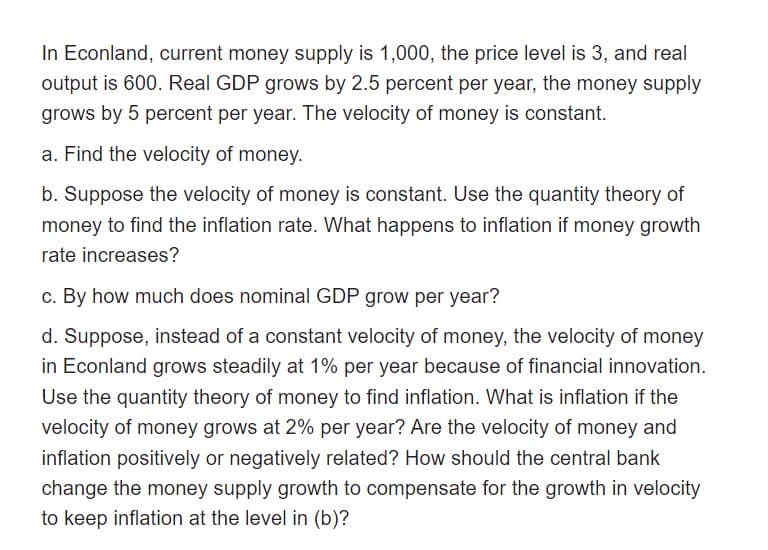In Econland, current money supply is 1,000, the price level is 3, and real output is 600. Real GDP grows by 2.5 percent per year, the money supply grows by 5 percent per year. The velocity of money is constant. a. Find the velocity of money. b. Suppose the velocity of money is constant. Use the quantity theory of money to find the inflation rate. What happens to inflation if money growth
In Econland, current money supply is 1,000, the price level is 3, and real output is 600. Real GDP grows by 2.5 percent per year, the money supply grows by 5 percent per year. The velocity of money is constant. a. Find the velocity of money. b. Suppose the velocity of money is constant. Use the quantity theory of money to find the inflation rate. What happens to inflation if money growth
Chapter15: Monetary Theory And Policy
Section: Chapter Questions
Problem 3.7P
Related questions
Question
Please help on Part C and D.

Transcribed Image Text:In Econland, current money supply is 1,000, the price level is 3, and real
output is 600. Real GDP grows by 2.5 percent per year, the money supply
grows by 5 percent per year. The velocity of money is constant.
a. Find the velocity of money.
b. Suppose the velocity of money is constant. Use the quantity theory of
money to find the inflation rate. What happens to inflation if money growth
rate increases?
c. By how much does nominal GDP grow per year?
d. Suppose, instead of a constant velocity of money, the velocity of money
in Econland grows steadily at 1% per year because of financial innovation.
Use the quantity theory of money to find inflation. What is inflation if the
velocity of money grows at 2% per year? Are the velocity of money and
inflation positively or negatively related? How should the central bank
change the money supply growth to compensate for the growth in velocity
to keep inflation at the level in (b)?
Expert Solution
This question has been solved!
Explore an expertly crafted, step-by-step solution for a thorough understanding of key concepts.
This is a popular solution!
Trending now
This is a popular solution!
Step by step
Solved in 2 steps

Knowledge Booster
Learn more about
Need a deep-dive on the concept behind this application? Look no further. Learn more about this topic, economics and related others by exploring similar questions and additional content below.Recommended textbooks for you


Brief Principles of Macroeconomics (MindTap Cours…
Economics
ISBN:
9781337091985
Author:
N. Gregory Mankiw
Publisher:
Cengage Learning

Principles of Economics (MindTap Course List)
Economics
ISBN:
9781305585126
Author:
N. Gregory Mankiw
Publisher:
Cengage Learning


Brief Principles of Macroeconomics (MindTap Cours…
Economics
ISBN:
9781337091985
Author:
N. Gregory Mankiw
Publisher:
Cengage Learning

Principles of Economics (MindTap Course List)
Economics
ISBN:
9781305585126
Author:
N. Gregory Mankiw
Publisher:
Cengage Learning

Principles of Economics, 7th Edition (MindTap Cou…
Economics
ISBN:
9781285165875
Author:
N. Gregory Mankiw
Publisher:
Cengage Learning

Principles of Macroeconomics (MindTap Course List)
Economics
ISBN:
9781305971509
Author:
N. Gregory Mankiw
Publisher:
Cengage Learning

Principles of Macroeconomics (MindTap Course List)
Economics
ISBN:
9781285165912
Author:
N. Gregory Mankiw
Publisher:
Cengage Learning